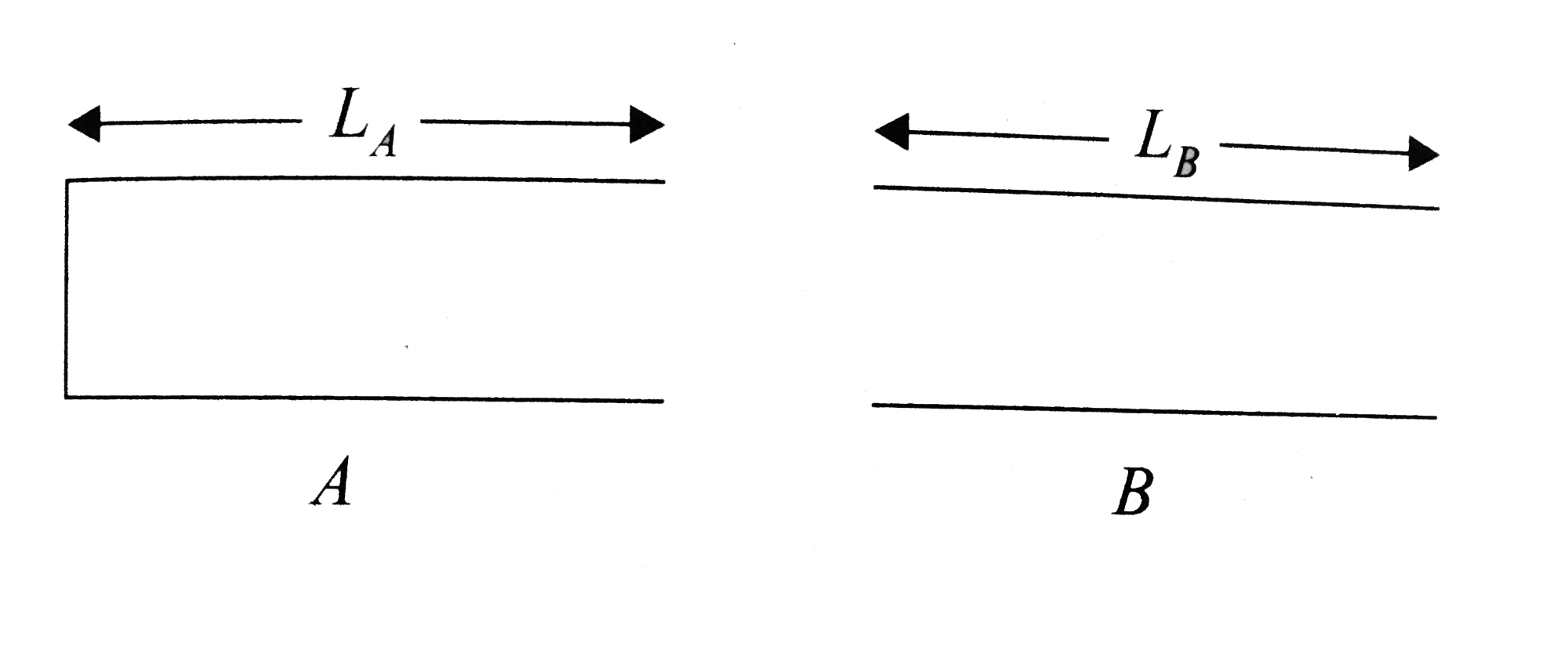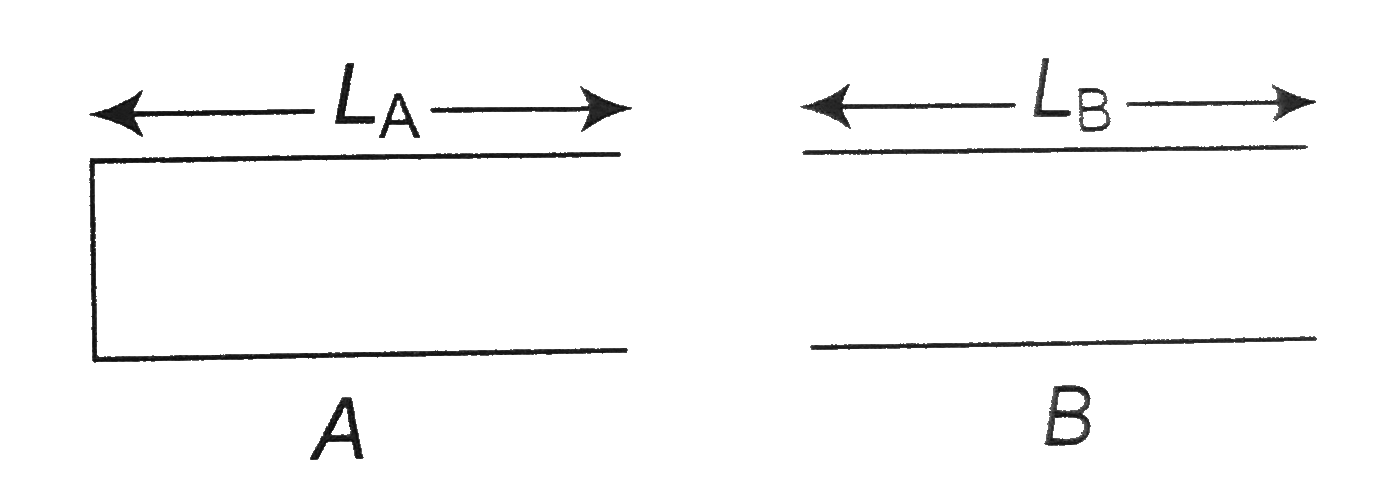Pipe A , with length L , and pipe B , with length 2l , both have two open ends. Which harmonic of pipe B has the same frequency as the fundamental of pipe A ?
To solve the problem of determining which harmonic of pipe B has the same frequency as the fundamental frequency of pipe A, we can follow these steps:
Step 1: Understand the fundamental frequency of pipe A
For a pipe with both ends open, the fundamental frequency (first harmonic) is given by the formula:
fA=v2L
where:
- v is the speed of sound in air,
- L is the length of pipe A.
Step 2: Determine the frequency for pipe B
Pipe B has a length of 2L. The fundamental frequency for pipe B can be calculated using the same formula:
fB=v2(2L)=v4L
Step 3: Identify the harmonic frequencies of pipe B
For a pipe open at both ends, the frequency of the nth harmonic is given by:
fn=nv2L
For pipe B, which has a length of 2L, the frequency of the nth harmonic is:
f′n=nv4L
Step 4: Set the frequencies equal to find the harmonic
We want to find the harmonic n of pipe B such that:
f′n=fA
Substituting the expressions we derived:
nv4L=v2L
Step 5: Simplify the equation
Cancel v and L from both sides:
n4=12
Multiplying both sides by 4 gives:
n=2
Conclusion
The second harmonic of pipe B has the same frequency as the fundamental frequency of pipe A.
Summary
- The fundamental frequency of pipe A is fA=v2L.
- The second harmonic of pipe B (length 2L) is f′2=2v4L=v2L.
- Therefore, the answer is that the second harmonic of pipe B has the same frequency as the fundamental frequency of pipe A.
---
For a pipe with both ends open, the fundamental frequency (first harmonic) is given by the formula:
fA=v2L
where:
- v is the speed of sound in air,
- L is the length of pipe A.
Pipe B has a length of 2L. The fundamental frequency for pipe B can be calculated using the same formula:
fB=v2(2L)=v4L
For a pipe open at both ends, the frequency of the nth harmonic is given by:
fn=nv2L
For pipe B, which has a length of 2L, the frequency of the nth harmonic is:
f′n=nv4L
We want to find the harmonic n of pipe B such that:
f′n=fA
Substituting the expressions we derived:
nv4L=v2L
Cancel v and L from both sides:
n4=12
Multiplying both sides by 4 gives:
n=2
The second harmonic of pipe B has the same frequency as the fundamental frequency of pipe A.
- The fundamental frequency of pipe A is fA=v2L.
- The second harmonic of pipe B (length 2L) is f′2=2v4L=v2L.
- Therefore, the answer is that the second harmonic of pipe B has the same frequency as the fundamental frequency of pipe A.
Topper's Solved these Questions
- WAVE - IIBOOK - RESNICK AND HALLIDAYCHAPTER - WAVE - IIEXERCISE - PROBLEMS
59 Videos
- WAVE - IIBOOK - RESNICK AND HALLIDAYCHAPTER - WAVE - IIEXERCISE - PRACTICE QUESTIONS (SINGLE CORRECT CHOICE TYPE)
35 Videos
- WAVE - IIBOOK - RESNICK AND HALLIDAYCHAPTER - WAVE - IIEXERCISE - PRACTICE QUESTIONS (INTEGER TYPE)
5 Videos
- VECTORS BOOK - RESNICK AND HALLIDAYCHAPTER - VECTORS EXERCISE - PRACTICE QUESTIONS
39 Videos
- WAVES-IBOOK - RESNICK AND HALLIDAYCHAPTER - WAVES-IEXERCISE - Practice Questions (Integer Type)
4 Videos
Similar Questions
Pipe A has length twice the pipe B. Pipe A has both ends open and pipe B has one end open. Which harmonics of pipe A have a frequency that matches a resonance frequency of pipe B.
View SolutionOrgan pipe A, with both ends open, has a fundamental frequency of 425 Hz. The fifth harmonic of organ pipe B, with one end open, has the same frequency as the second harmonic of pipe A. How long are (a) pipe A and (b) pipe B?
View Solution
Knowledge Check
Two pipes are submerged in sea water , arranged as shown in figure . Pipe (A) with length LA=1.5m and one open end , contains a small source that sets up the standing wave with the second lowest resonant frequency of that pipe . Sound from pipe A sets up resonance in pipe B , which has both ends open . The resonance is at the second lowest resonant frequency of pipe B. The length of the pipe B is :
 A1mB1.5mC2mD3m
A1mB1.5mC2mD3mIn an open end organ pipe of length l if the speed of sound is V then the fundamental frequency will be
AV2l and both odd as well as even harmonics are presentBV4l & both odd as well as even harmonics are presentCV2l and only even harmonics are presentDV4l and only even harmonics are presentFor an open organ pipe of length l the wavelength of the fundamental note is equal to-
AlBl/2Cl/4D2l
The fundamental frequency of a closed pipe is 220HZ.
(a) Find the length of this pipe.
(b) The second overtone of this pipe has the same frequency as the third harmonic of an open pipe. Find the length of this open pipe. Take speed of sound in air 345m/s.
View Solution
The two pipes are submerged in sea water, arranged as shown in figure. Pipe A with length LA=1.5m and one open end, contains a small sound source that sets up the standing wave with the second lowest resonant frequency of that pipe. Sound from pipe A sets up resonance in pipe B, which has both ends open. The resonance is at the second lowest resonant frequency of pipe B. The length of the pipe B is
View SolutionDifferentiate between closed pipe and open pipe at both ends of same length fro frequency of fundamental note and harmonics.
View SolutionPipe A is 0.50 m long and open at both ends. Pipe B is open at one end and closed at the other end. Determine the length of pipe B so that it has the same fundamental frequency as A.
View SolutionIn an organ pipe of length L open at both ends, the fundamental mode has a frequency
(where v is a speed of sound in air)
View Solution
